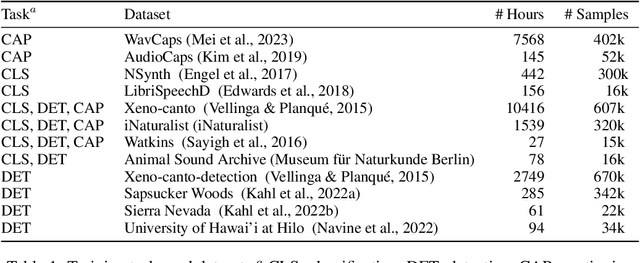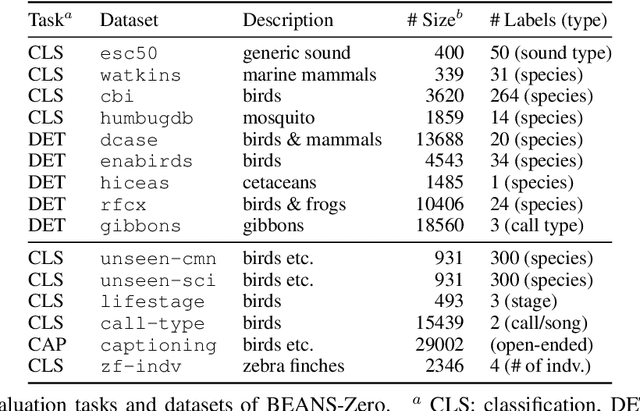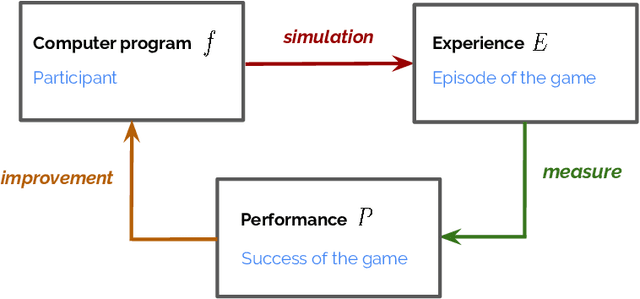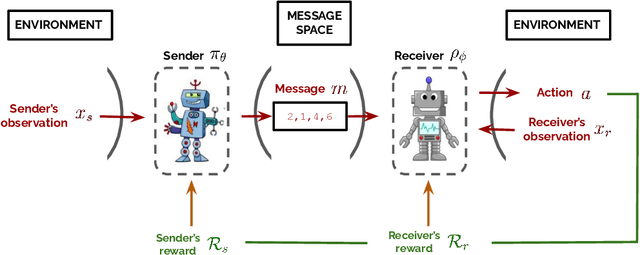Olivier Pietquin
Crossing the Species Divide: Transfer Learning from Speech to Animal Sounds
Sep 04, 2025Abstract:Self-supervised speech models have demonstrated impressive performance in speech processing, but their effectiveness on non-speech data remains underexplored. We study the transfer learning capabilities of such models on bioacoustic detection and classification tasks. We show that models such as HuBERT, WavLM, and XEUS can generate rich latent representations of animal sounds across taxa. We analyze the models properties with linear probing on time-averaged representations. We then extend the approach to account for the effect of time-wise information with other downstream architectures. Finally, we study the implication of frequency range and noise on performance. Notably, our results are competitive with fine-tuned bioacoustic pre-trained models and show the impact of noise-robust pre-training setups. These findings highlight the potential of speech-based self-supervised learning as an efficient framework for advancing bioacoustic research.
ShiQ: Bringing back Bellman to LLMs
May 16, 2025Abstract:The fine-tuning of pre-trained large language models (LLMs) using reinforcement learning (RL) is generally formulated as direct policy optimization. This approach was naturally favored as it efficiently improves a pretrained LLM, seen as an initial policy. Another RL paradigm, Q-learning methods, has received far less attention in the LLM community while demonstrating major success in various non-LLM RL tasks. In particular, Q-learning effectiveness comes from its sample efficiency and ability to learn offline, which is particularly valuable given the high computational cost of sampling with LLMs. However, naively applying a Q-learning-style update to the model's logits is ineffective due to the specificity of LLMs. Our core contribution is to derive theoretically grounded loss functions from Bellman equations to adapt Q-learning methods to LLMs. To do so, we carefully adapt insights from the RL literature to account for LLM-specific characteristics, ensuring that the logits become reliable Q-value estimates. We then use this loss to build a practical algorithm, ShiQ for Shifted-Q, that supports off-policy, token-wise learning while remaining simple to implement. Finally, we evaluate ShiQ on both synthetic data and real-world benchmarks, e.g., UltraFeedback and BFCL-V3, demonstrating its effectiveness in both single-turn and multi-turn LLM settings
Robust detection of overlapping bioacoustic sound events
Mar 04, 2025Abstract:We propose a method for accurately detecting bioacoustic sound events that is robust to overlapping events, a common issue in domains such as ethology, ecology and conservation. While standard methods employ a frame-based, multi-label approach, we introduce an onset-based detection method which we name Voxaboxen. It takes inspiration from object detection methods in computer vision, but simultaneously takes advantage of recent advances in self-supervised audio encoders. For each time window, Voxaboxen predicts whether it contains the start of a vocalization and how long the vocalization is. It also does the same in reverse, predicting whether each window contains the end of a vocalization, and how long ago it started. The two resulting sets of bounding boxes are then fused using a graph-matching algorithm. We also release a new dataset designed to measure performance on detecting overlapping vocalizations. This consists of recordings of zebra finches annotated with temporally-strong labels and showing frequent overlaps. We test Voxaboxen on seven existing data sets and on our new data set. We compare Voxaboxen to natural baselines and existing sound event detection methods and demonstrate SotA results. Further experiments show that improvements are robust to frequent vocalization overlap.
NatureLM-audio: an Audio-Language Foundation Model for Bioacoustics
Nov 11, 2024



Abstract:Large language models (LLMs) prompted with text and audio represent the state of the art in various auditory tasks, including speech, music, and general audio, showing emergent abilities on unseen tasks. However, these capabilities have yet to be fully demonstrated in bioacoustics tasks, such as detecting animal vocalizations in large recordings, classifying rare and endangered species, and labeling context and behavior - tasks that are crucial for conservation, biodiversity monitoring, and the study of animal behavior. In this work, we present NatureLM-audio, the first audio-language foundation model specifically designed for bioacoustics. Our carefully curated training dataset comprises text-audio pairs spanning a diverse range of bioacoustics, speech, and music data, designed to address the challenges posed by limited annotated datasets in the field. We demonstrate successful transfer of learned representations from music and speech to bioacoustics, and our model shows promising generalization to unseen taxa and tasks. Importantly, we test NatureLM-audio on a novel benchmark (BEANS-Zero) and it sets the new state of the art (SotA) on several bioacoustics tasks, including zero-shot classification of unseen species. To advance bioacoustics research, we also open-source the code for generating training and benchmark data, as well as for training the model.
Biodenoising: animal vocalization denoising without access to clean data
Oct 04, 2024Abstract:Animal vocalization denoising is a task similar to human speech enhancement, a well-studied field of research. In contrast to the latter, it is applied to a higher diversity of sound production mechanisms and recording environments, and this higher diversity is a challenge for existing models. Adding to the challenge and in contrast to speech, we lack large and diverse datasets comprising clean vocalizations. As a solution we use as training data pseudo-clean targets, i.e. pre-denoised vocalizations, and segments of background noise without a vocalization. We propose a train set derived from bioacoustics datasets and repositories representing diverse species, acoustic environments, geographic regions. Additionally, we introduce a non-overlapping benchmark set comprising clean vocalizations from different taxa and noise samples. We show that that denoising models (demucs, CleanUNet) trained on pseudo-clean targets obtained with speech enhancement models achieve competitive results on the benchmarking set. We publish data, code, libraries, and demos https://mariusmiron.com/research/biodenoising.
Averaging log-likelihoods in direct alignment
Jun 27, 2024



Abstract:To better align Large Language Models (LLMs) with human judgment, Reinforcement Learning from Human Feedback (RLHF) learns a reward model and then optimizes it using regularized RL. Recently, direct alignment methods were introduced to learn such a fine-tuned model directly from a preference dataset without computing a proxy reward function. These methods are built upon contrastive losses involving the log-likelihood of (dis)preferred completions according to the trained model. However, completions have various lengths, and the log-likelihood is not length-invariant. On the other side, the cross-entropy loss used in supervised training is length-invariant, as batches are typically averaged token-wise. To reconcile these approaches, we introduce a principled approach for making direct alignment length-invariant. Formally, we introduce a new averaging operator, to be composed with the optimality operator giving the best policy for the underlying RL problem. It translates into averaging the log-likelihood within the loss. We empirically study the effect of such averaging, observing a trade-off between the length of generations and their scores.
Contrastive Policy Gradient: Aligning LLMs on sequence-level scores in a supervised-friendly fashion
Jun 27, 2024Abstract:Reinforcement Learning (RL) has been used to finetune Large Language Models (LLMs) using a reward model trained from preference data, to better align with human judgment. The recently introduced direct alignment methods, which are often simpler, more stable, and computationally lighter, can more directly achieve this. However, these approaches cannot optimize arbitrary rewards, and the preference-based ones are not the only rewards of interest for LLMs (eg., unit tests for code generation or textual entailment for summarization, among others). RL-finetuning is usually done with a variation of policy gradient, which calls for on-policy or near-on-policy samples, requiring costly generations. We introduce Contrastive Policy Gradient, or CoPG, a simple and mathematically principled new RL algorithm that can estimate the optimal policy even from off-policy data. It can be seen as an off-policy policy gradient approach that does not rely on important sampling techniques and highlights the importance of using (the right) state baseline. We show this approach to generalize the direct alignment method IPO (identity preference optimization) and classic policy gradient. We experiment with the proposed CoPG on a toy bandit problem to illustrate its properties, as well as for finetuning LLMs on a summarization task, using a learned reward function considered as ground truth for the purpose of the experiments.
Countering Reward Over-optimization in LLM with Demonstration-Guided Reinforcement Learning
Apr 30, 2024



Abstract:While Reinforcement Learning (RL) has been proven essential for tuning large language models (LLMs), it can lead to reward over-optimization (ROO). Existing approaches address ROO by adding KL regularization, requiring computationally expensive hyperparameter tuning. Additionally, KL regularization focuses solely on regularizing the language policy, neglecting a potential source of regularization: the reward function itself. Inspired by demonstration-guided RL, we here introduce the Reward Calibration from Demonstration (RCfD), which leverages human demonstrations and a reward model to recalibrate the reward objective. Formally, given a prompt, the RCfD objective minimizes the distance between the demonstrations' and LLM's rewards rather than directly maximizing the reward function. This objective shift avoids incentivizing the LLM to exploit the reward model and promotes more natural and diverse language generation. We show the effectiveness of RCfD on three language tasks, which achieves comparable performance to carefully tuned baselines while mitigating ROO.
Language Evolution with Deep Learning
Mar 18, 2024



Abstract:Computational modeling plays an essential role in the study of language emergence. It aims to simulate the conditions and learning processes that could trigger the emergence of a structured language within a simulated controlled environment. Several methods have been used to investigate the origin of our language, including agent-based systems, Bayesian agents, genetic algorithms, and rule-based systems. This chapter explores another class of computational models that have recently revolutionized the field of machine learning: deep learning models. The chapter introduces the basic concepts of deep and reinforcement learning methods and summarizes their helpfulness for simulating language emergence. It also discusses the key findings, limitations, and recent attempts to build realistic simulations. This chapter targets linguists and cognitive scientists seeking an introduction to deep learning as a tool to investigate language evolution.
Population-aware Online Mirror Descent for Mean-Field Games by Deep Reinforcement Learning
Mar 06, 2024Abstract:Mean Field Games (MFGs) have the ability to handle large-scale multi-agent systems, but learning Nash equilibria in MFGs remains a challenging task. In this paper, we propose a deep reinforcement learning (DRL) algorithm that achieves population-dependent Nash equilibrium without the need for averaging or sampling from history, inspired by Munchausen RL and Online Mirror Descent. Through the design of an additional inner-loop replay buffer, the agents can effectively learn to achieve Nash equilibrium from any distribution, mitigating catastrophic forgetting. The resulting policy can be applied to various initial distributions. Numerical experiments on four canonical examples demonstrate our algorithm has better convergence properties than SOTA algorithms, in particular a DRL version of Fictitious Play for population-dependent policies.
 Add to Chrome
Add to Chrome Add to Firefox
Add to Firefox Add to Edge
Add to Edge